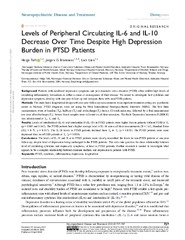Levels of Peripheral Circulating IL-6 and IL-10 Decrease Over Time Despite High Depression Burden in PTSD Patients
Permanent lenke
https://hdl.handle.net/10037/25558Dato
2022-04-05Type
Journal articleTidsskriftartikkel
Peer reviewed
Sammendrag
Methods: The study had a longitudinal design with one-year follow-up measurements in an inpatient treatment setting at a psychiatric center in Norway. PTSD diagnoses were set using the Mini International Neuropsychiatric Interview (MINI). The first three measurements were at baseline (T0), halfway (T1) and at discharge (T2) from a 12-week main stay, followed by a final measurement one year after discharge (T3). Serum blood samples were collected on all four occasions. The Beck Depression Inventory-II (BDI-II) was administered at T0, T2 and T3.
Results: Levels of interleukin-6 (IL-6) and interleukin-10 (IL-10) in PTSD patients were higher than in patients without PTSD at T0 (p = 0.005 and 0.042). The PTSD patients had a higher average level of IL-10 across all four measurements (B = 1.62, Standard Error (SE) = 0.78, p = 0.037). The IL-10 levels in PTSD patients declined from T0 to T3 (p = 0.039). The PTSD patients were more depressed than non-PTSD patients at T3 (p = 0.019).
Conclusions: The levels of IL-10 and IL-6 in PTSD patients more closely resembled the levels in non-PTSD patients at one-year follow-up, despite level of depression being unchanged in the PTSD patients. This calls into question the close relationship between level of circulating cytokines and depressive symptoms, at least in PTSD patients. Further research is needed to investigate what appears to be a complex relationship between immune markers and depression in patients with PTSD.


 English
English norsk
norsk